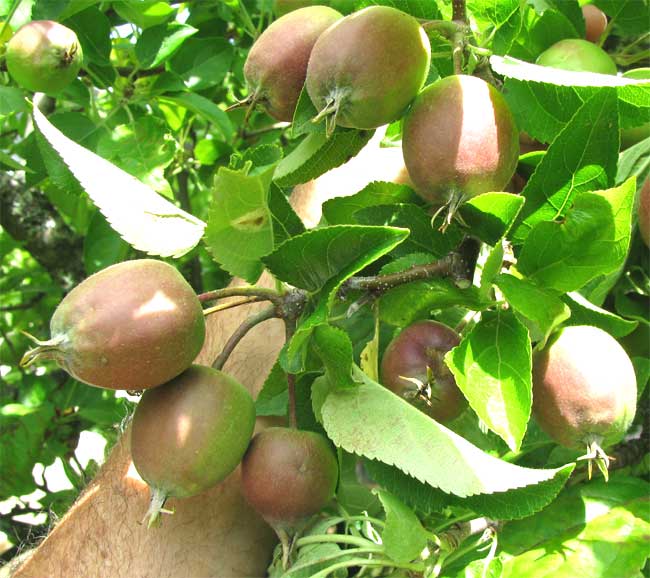Excerpts from Jim Conrad's
Naturalist Newsletter

from the June 21, 2009 Newsletter, issued from the Siskiyou Mountains west of Grants Pass, Oregon:
THINNING APPLES
My most pleasant task this week was to thin apples in my friends' little orchard. Often apple trees produce so many close-together apples that general wisdom insists that some of the apples should be thinned out, else a crop of many tiny, knobby apples will result.
Already the trees had partially thinned themselves without anyone's help, littering the grass below them with small, ill-formed, puckered fruits. I've heard of this "June drop" and here it was happening exactly when it should. Still, all the trees needed further thinning. For example, look at the cluster above.
Thing is, everyone has his or her own philosophy for how many apples need to be thinned out. On an Internet blog an unnamed apple-thinner says that at first he didn't thin his trees at all, figuring that a lot of small apples was just as good as a few big ones, but after a few years he realized that "... whenever a tree would produce an especially heavy crop of apples, it would exhaust itself ripening them and next year there would usually be no crop at all."
Here is this person's advice: "When I'm sure they've all dropped all the fruit they're going to, then I have to go in with a pair of scissors and snip stems until they're down to one or two apples per spur. Purists say that you should have four to six inches between apples, but I'll leave them a little closer if it looks like they're not going to crowd each other too much."
Most professionals seem to shoot for just one apple per spur and they want remaining apples to be about a hand-althy and gets lots of sun, I'll leave them maybe four inches apart, but in less ideal parts of the tree not closer than a hand-width.
If you're not sure what a spur is, in the photo's bottom, left corner three apples arise from one short stem. That short stem is a spur. I removed two of those three apples, the least robust, healthy ones. At the picture's center-top there's another cluster of three, and that was reduced to one apple, too. At the lower right, there's a cluster of 2, and I removed the smaller one. So, what was eight crowded apples I converted to three.
Some apple varieties tend to bear every other year. Sometimes hand thinning breaks this biennial cycle, resulting in larger, better shaped fruit each year.
All the horticultural stuff aside, what a pleasure being on a ladder inside a super-green tree with little red globes suspended all around, the fresh air, birds coming and going, sunlight, the odor of crushed leaves, the pleasant tiredness after you've been at it for awhile, lying in the grass resting, looking up at what you've done, thinking of those big, beautiful apples to come...
APPLE TREE HAIKU
Working inside those apple trees was like being in a big Haiku poem. Haikus express much in only seventeen syllables in 5:7:5 form. The most cherished Haiku capture a complex emotion or circumstance in elegant, crisp understatement.
So, there I was suspended among solar receptors, the leaves, my whole world bedazzled with green and yellow light translucing through and being reflected by leaves, all that well functioning and beautiful machinery grinding toward the output of perfect apples.
In a few graceful utterances of leaf, stem, shadow, glow and essence, those Haiku-apple-trees spoke profoundly on the fundamental condition of Life on Earth, which is that sunlight fuels the ecosystem in which living things, including us, are enmeshed. And that the whole thing considered together is unutterably beautiful.
An unspoken dynamic of apple trees being Haikus is the implication that the poet is the Universal Creative Force, and you know that I regard myself as a nerve ending of The Force, my experiences as a living creature letting the Force know how things are going in this part of Her Creation.
It may be worth digressing here:
For, there remains in me enough of my history as a Kentucky farmboy rooted in traditional, conservative ways of doing things, thinking about the world and articulating myself to feel rather flaky when I express myself the way I just have. I am vividly aware of how people such as those I am from view such sacrilegious, air-headed (they would call it) and probably unpatriotic or even subversive chatter.
Yet, one insight my 61 years on Earth have imparted to me is that certain of the more important and interesting realms of reality are so abstract and complex that everyday words and everyday ways of expressing oneself about them are inadequate. To articulate about universal, profoundly meaningful and spiritual matters, one must resort to metaphor, allegory, and symbolism of the most varied kind, in the most artful manner. Especially now when the planetary biosphere is collapsing as a consequence of unenlightened human activity, one must speak up in ways that penetrate crusts of insensitivity, ignorance and inappropriate programming. So...
Any creature with a reptilian brain-root can be content on a warm rock looking around, but you need to take advantage of the Sixth Miracle of Nature and the primate corner of the mammalian brain to rejoice in being inside an apple-tree poem, to consciously resonate with that poem, and seek to carry the poem's mystical imagery and energy forward: